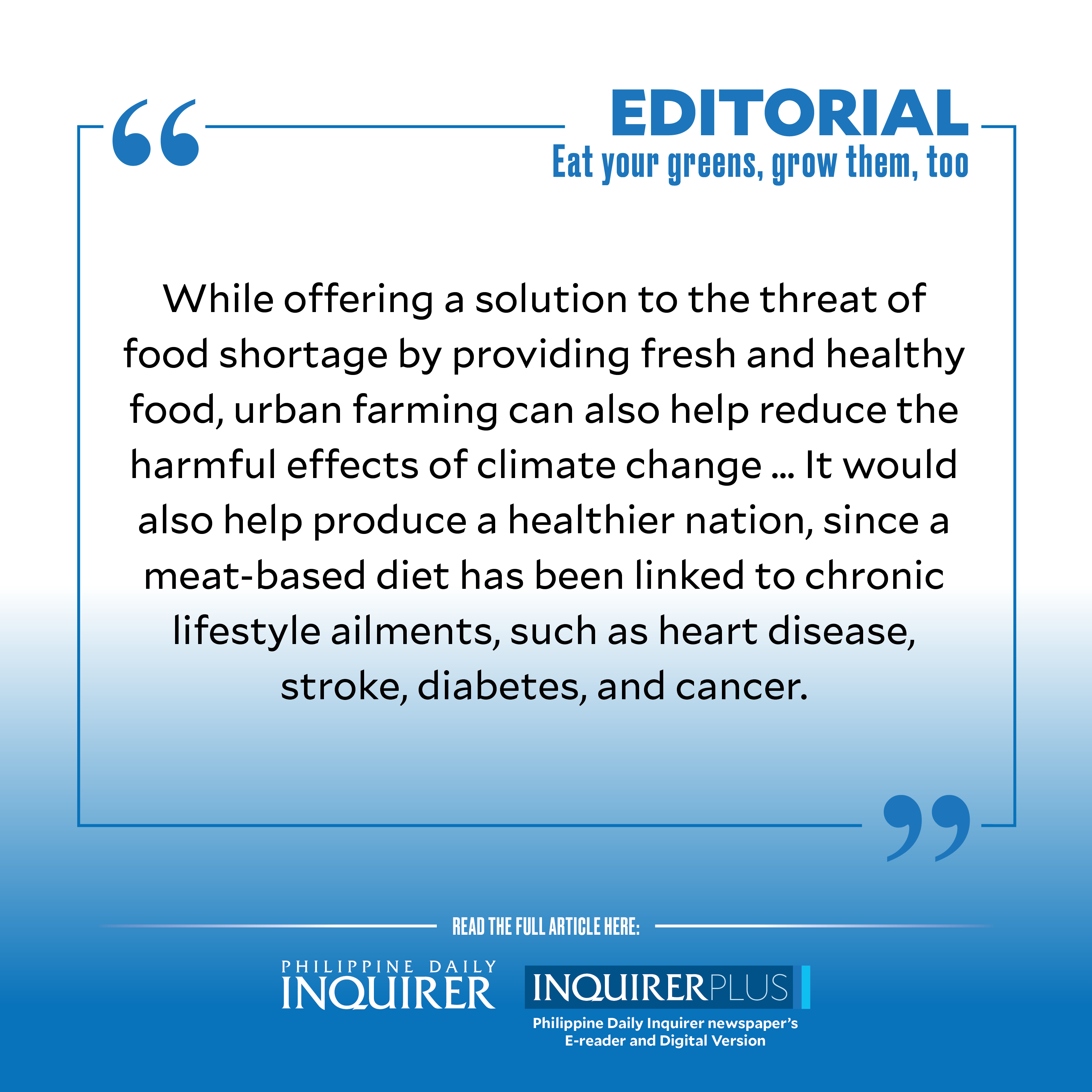Eat your greens, grow them, too

It comes as no surprise to learn that Filipino families eat only 60 kilograms of vegetables a year, half of the world’s average of 120 kg.
Blame it partly on the unique place of pork in our history, cultural practice, and diet. Aside from pigs being indigenous in the Philippines where killing the animal is part of some animistic rituals, our appetite for pork was reinforced by our colonizer Spain, which, incidentally, is among the world’s top meat-eating country. At the time of Spain’s inquisition in Europe from the 13th to the 19th century, when Jews, Muslims, Protestants, and other individuals suspected of being in conflict with Catholic beliefs were targeted, eating pork—which is anathema to both Islam and Judaism—became proof that one did not subscribe to either religion, and was therefore safe from execution.
In more recent times and with scores of affordable and tasty food options available, vegetables became a last choice on the table, obligatory in one’s diet only because of their nutritive value, but seldom served as the main dish. The onslaught of some 20 typhoons a year that regularly drown vegetable farms in the country has also resulted in a spike in prices, further dooming this healthy alternative.
In a recent forum, former Department of Agriculture secretary William Dar pointed out the need for a bigger budget to encourage urban farming, which he introduced during his term at the DA in 2020.
As the Philippines is “rice-centric,” Dar said 60 to 65 percent of the DA budget has been devoted to this staple crop.
Urban farming
For this year, Gerald Glenn Panganiban of the Bureau of Plant Industry said the DA had allocated P430 million for urban farming, hardly enough to be able to encourage and support community efforts to sustain this food security initiative.
Which is a pity considering the benefits of urban farming, among them its steadfast survival amid the possible impact of the El Niño phenomenon. “Urban farming minimizes use of water and because the environment is controlled, it is not affected by drought or typhoon,” Panganiban said.
In its Special Area for Agricultural Development program website, the DA gave an overview on urban agriculture, and how it can exist in even densely populated cities in many forms: as community and backyard gardens; on rooftops, balconies, and vacant lots, as vertical gardens, and through hydroponics, a soilless method of growing food using mineral nutrient solutions in water.
Weekend farmers
Small or limited space in the urban jungle has not stopped some local government units from starting community gardens, as Bonifacio Global City did, with its BGC Urban Farm launched in March this year. For a certain monthly fee, ordinary folk can adopt a vegetable plot, or volunteer as a weekend farmer. Partner farmers are around to teach the ropes of urban farming to those interested, while fresh farm harvests and farming essentials are sold on-site.
The lockdown and resulting job loss during the COVID-19 pandemic meanwhile prompted the Food Security Task Force of the Quezon City government to visit urban poor communities and distribute free seed starter kits, as part of #GrowQC’s urban farming and food security program that the city mayor started some 10 years back. The kit contained seeds of various vegetables, pots, and other planting materials that helped turn a previously vacant lot being used as a dump site into a vegetable garden. It now provides not only food to the community but also dignity and hope to the planters.
To encourage more people to engage in urban agriculture, Quezon City also offers tax exemptions to residents willing to use vacant or idle lands for planting food crops, an incentive that other cities can adopt. It’s also a starter project that newly elected barangay and Sangguniang Kabataan officials can emulate.
Vegetable plots in schools
And, as Dar noted, urban gardening can be part of the school curriculum, with vegetable plots in the campus providing students a hands-on learning experience. Tending such greens should also lead children to consume more vegetables if only out of pride over growing their own food. Character-building could be an inadvertent fruit of this school subject as well, since patience and hard work are needed to coax plants and vegetables to grow and flourish.
While offering a solution to the threat of food shortage by providing fresh and healthy food, urban farming can also help reduce the harmful effects of climate change. The livestock industry has been identified as among the significant contributors to greenhouse gas emissions, deforestation, and water pollution. Eating less meat and more greens would thus reduce such calamitous environmental impact. It would also help produce a healthier nation, since a meat-based diet has been linked to chronic lifestyle ailments, such as heart disease, stroke, diabetes, and cancer.
The DA apparently has its work cut out for it. It’s just a matter of having the political will to lead this worthy initiative.




















